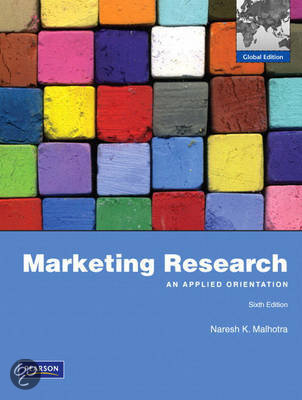MALHOTRA
CHAPTER 7 | CAUSAL RESEARCH DESIGN: EXPERIMENTATION
Experimentation is commonly used to infer causal relationships. The scientific notion of causality
implies that we can never prove that X causes Y. At best, we can only infer that X is one of the causes
of Y in that it makes the occurrence of Y probable.
CONDITIONS FOR CAUSALITY
Before making causal inferences, or assuming causality, three conditions must be
satisfied:
1. Concomitant variation
2. Time order of occurrence of variables
3. Elimination of other possible causal factors
CONCOMITANT VARIATION
Concomitant variation is the extent to which a cause, X, and an efect, Y, occur
together or vary together in the way predicted by the hypothesis under
consideration. Evidence pertaining to concomitant variation can be obtained in a
qualitative or quantitative manner.
TIME ORDER OF OCCURRENCE VARIABLES
The time order of occurrence condition states that the causing event must occur
either before or simultaneously with the efectt it cannot occur afterwards. By
definition, an efect cannot be produced by an event that occurs after the efect
has taken place. However, it is possible for each event in a relationship to be
both a cause and an efect of the other event. In other words, a variable can be
both a cause and an efect in the same causal relationship.
ABSENCE OF OTHER POSSIBLE CAUSAL FACTORS
The absence of other possible causal factors means that the factor or variable
being investigated should be the only possible causal explanation.
Evidence of concomitant variation, time order of occurrence of variables, and
elimination of other possible causal factors, even if combined, still do not
demonstrate conclusively that a causal relationship exists. However, if all the
evidence is strong and consistent, it may be reasonable to conclude that there is
a causal relationship. Accumulated evidence from several investigations
increases our confidence that a causal relationship exists. Confidence is further
enhanced if the evidence is interpreted in light of intimate conceptual knowledge
of the problem situation. Controlled experiments can provide strong evidence on
all three conditions.
DEFINITIONS AND CONCEPTS
, Independent variables or treatments are variables or alternatives that are
manipulated (i.e., the levels of these variables are changed by the
researcher) and whose efects are measured and compared.
Test units are individuals, organizations, or other entities whose response to
the independent variables or treatments is being examined (consumers,
stores, etc.)
Dependent variables are the variables that measure the efect of the
independent variables on the test units.
Extraneous variables are all variables other than the independent variables
that afect the response of the test units.
Experiment: an experiment is formed when the researcher manipulates one or more
independent variables and measures their effect on one or more dependent variables, while
controlling for the effect on extraneous variables.
Experimental design: an experimental design is a set of procedures specifying:
1. The test units and how these units are to be divided into homogeneous subsamples
2. What independent variables or treatments are to be manipulated
3. What dependent variables are to be measured
4. How the extraneous variables are to be controlled
A given group of test units was exposed to treatment variable X and the response was measured at two
different points in time, O1 and O2:
Two groups of test units were randomly assigned to two
diferent treatment groups at the same time, and the
dependent variable was measured in the two groups
simultaneously:
VALIDITY IN EXPERIMENTATION
Internal validity: refers to whether the manipulation of the independent variables or treatments
actually caused the observed effects on the dependent variables. Thus, internal validity examines
whether the observed effects on the test units could have been caused by variables other than the
treatment. If the observed effects are influenced or confounded by extraneous variables, it is difficult
to draw valid inferences about the causal relationship between the independent and dependent
variables. If an experiment lacks internal validity, it may not be meaningful to generalize the results.
Conduct experiment in artificial environment to enhance internal validity. However, this may
limit the generalizability of the results, thereby reducing external validity.
External validity: refers to whether the cause-and-effect relationships found in the experiment can be
generalized (generalizability). In other words, can the results be generalized beyond the experimental
situation, and if so, to what populations, settings, times, independent variables, and dependent
variables can the results be projected? Threats to external validity arise when the specific






